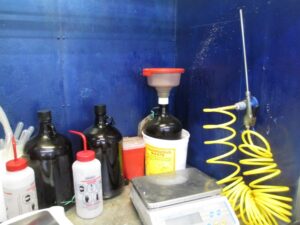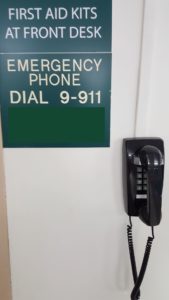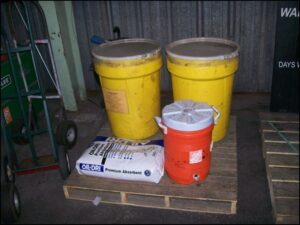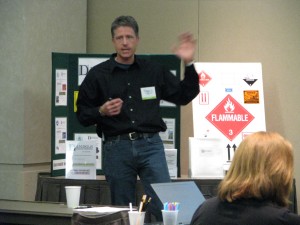Federal regulations of the U.S. Environmental Protection Agency (USEPA) mandate a small quantity generator of hazardous waste (SQG) take certain precautions to prepare for and prevent hazardous waste emergencies and to follow emergency procedures if one were to occur. These regulations are found within the SQG conditions of exemption at 40 CFR 262.16:
- 40 CFR 262.16(b)(8) Preparedness and prevention
- 40 CFR 262.16(b)(9) Emergency procedures
This article is the second in a series that closely examines these regulations and attempts to make them understandable.
The previous article in this series addressed 40 CFR 262.16(b)(8)(i) Maintenance and operation of facility.
The purpose of this article is to address the requirements of 40 CFR 262.16(b)(8)(ii) Required equipment.
Before we begin…
These regulations were revised by the Generator Improvements Rule. If your state has not yet adopted the new rule you must continue to comply with the earlier version until it does. You may read an article explaining the earlier version of the regulations (prior to implementation of the Generator Improvements Rule) here.
After your state adopts the Generator Improvements Rule, it may choose to make its version of these regulations more stringent and more broad than these Federal regulations. The actions of your state will vary based on whether or not it has an authorized hazardous waste program. Be sure to check the regulations of your state to ensure compliance.
Scope and Applicability:
These regulations are applicable to a SQG. The requirements of a large quantity generator of hazardous waste (LQG) are almost exactly the same. If you are a LQG please refer to this article for your version of these regulations: Emergency Preparedness and Prevention for Large Quantity Generator: Required Equipment.
|
Not sure of your hazardous waste generator status? |
As explained in more detail later in this article, these regulations solely apply to those areas of a SQG where hazardous waste is:
- Generated, i.e., the point of generation.
- Accumulated, i.e., central accumulation area and satellite accumulation area.
40 CFR 262.16(b)(8)(ii) reads:
All areas where hazardous waste is either generated or accumulated must be equipped with the items in paragraphs (b)(8)(ii)(A) through (D) of this section (unless none of the hazards posed by waste handled at the facility could require a particular kind of equipment specified below or the actual hazardous waste generation or accumulation area does not lend itself for safety reasons to have a particular kind of equipment specified below). A small quantity generator may determine the most appropriate locations to locate equipment necessary to prepare for and respond to emergencies:
(A) An internal communications or alarm system capable of providing immediate emergency instruction (voice or signal) to facility personnel;
(B) A device, such as a telephone (immediately available at the scene of operations) or a hand-held two-way radio, capable of summoning emergency assistance from local police departments, fire departments, or State or local emergency response teams;
(C) Portable fire extinguishers, fire control equipment (including special extinguishing equipment, such as that using foam, inert gas, or dry chemicals), spill control equipment, and decontamination equipment; and
(D) Water at adequate volume and pressure to supply water hose streams, or foam producing equipment, or automatic sprinklers, or water spray systems.
What changed?
The big change to this section is found in the introductory language (more on that below). USEPA noted that regulations prior to this revision were unclear regarding whether the required emergency response equipment must be placed in those areas of operation where hazardous waste is generated and accumulated or other parts of the facility where hazardous waste is not generated or accumulated.
USEPA also noted that it may not always be appropriate or safe to store equipment in the actual waste generation or accumulation area – even though the requirement itself applies only to the generation and accumulation (and treatment, as appropriate) of hazardous waste.
|
Interested in site specific training at your site that covers this topic, and more! Ask me about my Onsite Training |
Let’s take a closer look at the wording, terms, and phrases used in the introductory paragraph of §262.16(b)(8)(ii):
“All areas where hazardous waste is either generated or accumulated…” The revised preparedness and prevention regulations for a SQG lack a clear statement of their applicability (something that is included for the revised LQG regulations: 40 CFR 262.250 Applicability). In the preamble to the final rule in the Federal Register, USEPA stated its primary objective was to ensure these regulations do not apply to the entire facility (November 28, 2016, FR 81, 85792). However, USEPA did clarify that they – and all preparedness, prevention, and emergency response procedures of both SQG and LQG – are applicable to all areas of a facility where hazardous waste is generated or accumulated, this includes:
- Central accumulation areas (CAAs)
- Satellite accumulation areas (SAAs).
- Areas where allowable treatment takes place
- Areas where hazardous wastes are stored prior to off site transportation.
This does not include areas of the SQG where hazardous waste is neither generated nor accumulated.
New under the Generator Improvements Rule: all satellite accumulation areas operated by a SQG must meet the preparedness and prevention regulations of §262.16(b)(8) and emergency procedures of §262.16(b)(9). Previous agency guidance and enforcement limited the applicability of these regulations solely to hazardous waste in the CAA and did not include the SAA. To clarify its stated position in the preamble, USEPA also added the following to the revised regulations for SAAs at §262.15(a)(7):
All satellite accumulation areas operated by a small quantity generator must meet the preparedness and prevention regulations of §262.16(b)(8) and emergency procedures of §262.16(b)(9).
“…(unless none of the hazards posed by waste handled at the facility…” This language is unchanged from the regulations prior to the Generator Improvements Rule. It means that if the waste handled at your facility does not present a fire hazard – e.g., hydrochloric acid – you may not require any of the fire control equipment specified in paragraphs (c) and (d).
“…does not lend itself for safety reasons…” This text is new and reflects USEPA’s determination that the SQG should have the flexibility to store its equipment in other areas of the facility in situations where it is unsafe to have the equipment located immediately next to areas of hazardous waste generation or accumulation. The SQG may determine the most appropriate locations within its facility to locate equipment necessary to prepare for and respond to emergencies. The locations chosen for the required equipment must be chosen by the SQG for safety reasons only and not be based on cost or convenience.
|
Contact me with any questions you may have about the generation, identification, management, and disposal of hazardous waste Daniels Training Services, Inc. 815.821.1550 |
“A small quantity generator may determine…” This language is also new to the revised regulations. It is meant to provide flexibility for the SQG in determining the appropriate locations for its required equipment. It may also be viewed as an additional obligation for the SQG since now the regulations make clear the responsibility for determining the appropriate locations for its equipment is up to them and not a third party – even one with expertise in emergency preparedness and prevention.
In sum, the introductory paragraph communicates the following:
- All areas of a SQG where hazardous waste are generated or accumulated must be equipped with the required emergency response equipment.
However…
- Emergency equipment is not required if the the hazardous waste generated and accumulated by the SQG does not pose the hazards addressed by the emergency response equipment. i.e., no fire threat means no fire suppression equipment is needed.
And…
- Emergency equipment may be required but not placed in the area of hazardous waste accumulation or generation if the SQG believes it unsafe to do so.
And finally…
- The SQG may determine the most appropriate locations for emergency response equipment within its facility.
The remainder of this article will identify and explain what §262.16(b)(8)(ii) includes as required equipment. This language is unchanged from prior to the Generator Improvements Rule revisions.
The required equipment:
“An internal communications or alarm system…”
- For use within the facility.
- May be a system that communicates information (e.g., a public address or intercom) or an alarm system.
- Must provide immediate emergency instruction by voice or signal. That is, it must tell facility personnel what they must do in an emergency. This could be done by a live or pre-recorded voice speaking instructions or it could be an alarm system (signal) to which trained personnel know how to respond.
Q: May an internal communications or alarm system be designated personnel who move throughout the facility in an emergency informing and instructing other personnel?
A: Yes. Nothing in §262.16(b)(8)(ii) requires the communications or alarm system to be delivered electronically. Nor does it preclude the use of designated personnel who deliver the necessary information in person. Just remember, whatever system used must provide, “immediate emergency instruction”.
Q: Would an air horn suffice for an alarm system?
A: Yes, if personnel were trained to know what the air horn blast means so that its use provides immediate instruction. e.g., one blast for evacuate, two blasts for stay in place, &etc.
|
Contact me the next time hazardous waste generator USEPA training is due to expire. |
“A device, such as a telephone…”
- The device must be capable of summoning emergency assistance from outside the facility. Therefore, it must be able to reach outside of the facility.
- The device may be any of the following:
- A telephone if it is immediately available in the area(s) where hazardous waste are generated or accumulated, i.e., “…at the scene of operations…”
- A hand-held two-way radio presumably in the possession of hazardous waste personnel.
- Some other device capable of summoning emergency assistance from outside the facility. While two examples of an acceptable device are provided: telephone and hand-held two-way radio, compliance is not restricted to just these two.
- Emergency assistance to be requested from:
- Local police departments.
- Fire departments.
- State or local emergency response teams.
Q: Is it acceptable to have all emergency communication – internal and external – routed through a central operator – on-site or off-site – and the operator makes all the necessary subsequent communications?
A: Yes. As long as both the hazardous waste personnel and the central operator are trained on and knowledgeable of the regulations for preparedness, prevention, and emergency procedures at a SQG.
“Portable fire extinguishers…”
- Required equipment for fire suppression includes the following:
- Portable fire extinguishers.
- Fire control equipment to address special fire hazards, such as those using:
- Foam
- Inert gas
- Dry chemicals
And not just fires…
- Spill control equipment applicable to the hazards posed by the hazardous waste generated and accumulated.
- Decontamination equipment for facility personnel who may respond to or be exposed to a hazardous waste emergency.
Your compliance with this paragraph will vary greatly depending on the types, amounts, and locations of hazardous waste generation and accumulation at your facility. Clearly an emphasis is put on fire suppression, so make certain you have addressed this at your facility based on the hazards present. You may also wish to consider other factors that may contribute to your fire risk even though they have nothing to do with your hazardous waste, such as:
- The construction materials of any structures.
- Location of natural gas or other fuel supply to the structure.
- Location, quantity, and type of other flammable materials (not wastes) stored on-site.
- Facility location and surrounding area.
Outside experts such as the Fire Marshall, local fire department, and insurance provider may be able to assist you in determining the risk of fire at your facility as a whole and specifically the hazards posed by your waste.
Spill control equipment and decontamination equipment are no less important than fire suppression and will also require you to consider the potential hazards posed by your waste and what equipment might be necessary to respond to a release of hazardous waste. Make certain your equipment is readily available, kept up-to-date (some spill absorbents and acid/base neutralizers may lose their effectiveness over time) and in sufficient quantities to respond to any release of a hazardous waste at your facility. Keep in mind that spill control and clean-up equipment are likely to be consumed over time for small spills and housekeeping and then may not be available in the event of a real emergency. Routine inspections of this equipment to ensure it is present and operating is a good idea.
“Water at adequate volume…”
- SQG must determine if it has water at adequate volume and pressure to supply the following fire suppression equipment:
- Water hose streams
- Foam producing equipment
- Automatic sprinklers
- Water spray systems
Q: What do I do as a SQG if I don’t believe I have an adequate supply of water for my fire suppression equipment?
A: USEPA does not specify the actions a SQG must take if it lacks adequate supply of water. Responses I have seen from hazardous waste generators to this situation include installation of the following:
- On-site water tower.
- Dig on-site well to supplement city water supply.
- Retention pond.
- Separate water line from city or municipality just for fire suppression.
|
Daniels Training Services, Inc. 815.821.1550 |
Is that it?
No. There are still the remainder of the emergency preparedness and prevention regulations for a SQG in §262.16(b)(8). Also, there are the SQG emergency procedures of §262.16(b)(9). And, right in the midst of the SQG emergency procedure regulations is where we will find the training requirements for a SQG at §262.16(b)(9)(iii).
The next article in this series: 40 CFR 262.16(b)(8)(iii) Testing and maintenance of equipment




